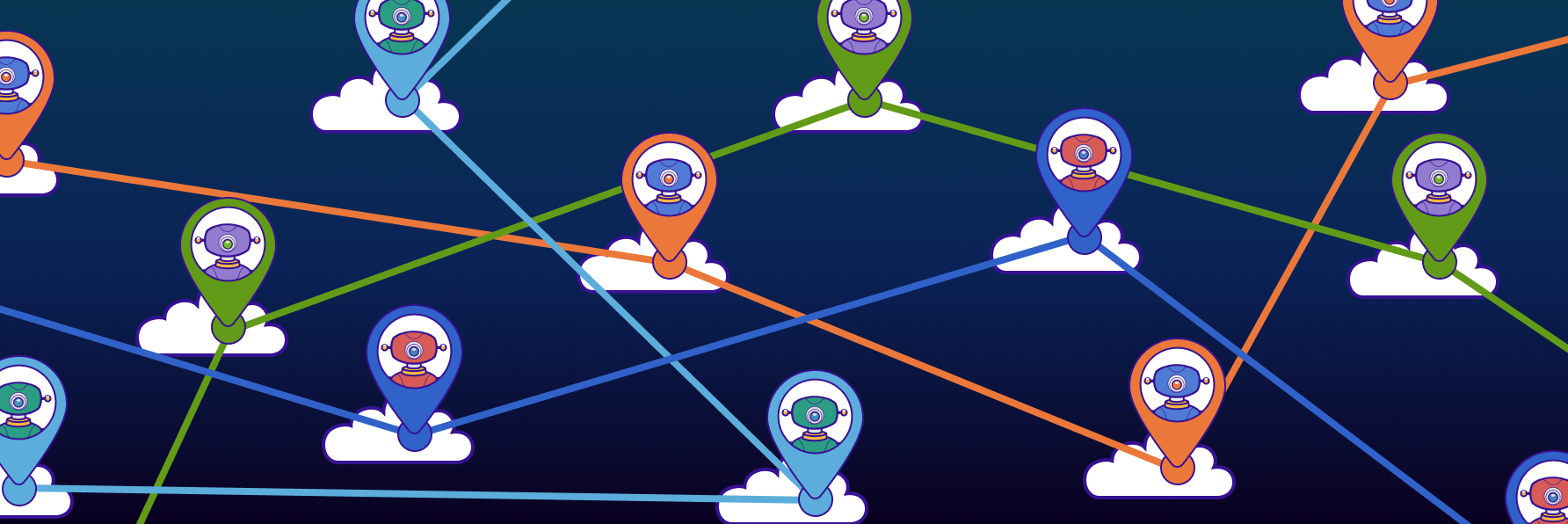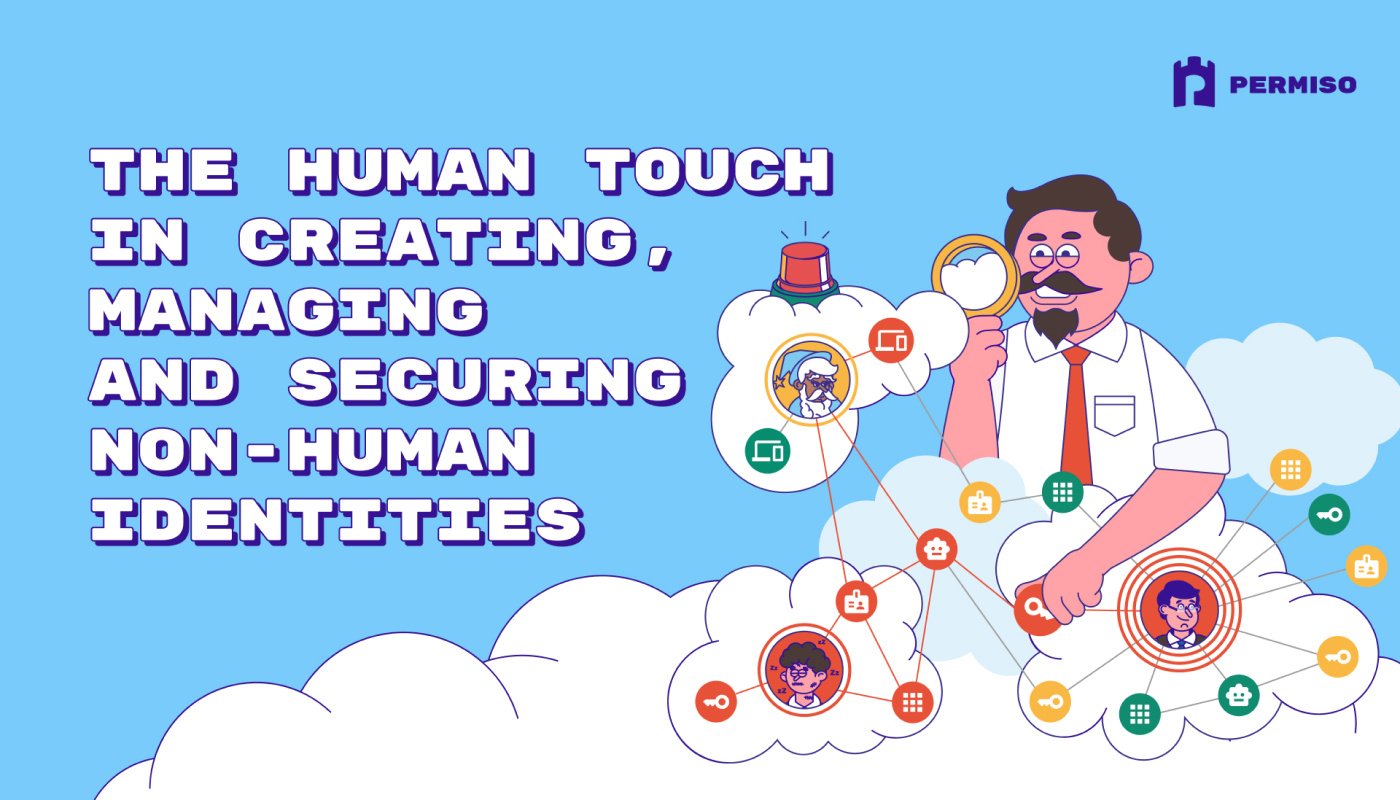What Are Non-Human Identities?

Table of Contents
Hear Ye, Hear Ye
Subscribe to Cloud Chronicles for the latest in cloud security!
Section 1
What Are Non-Human Identities?
Non-human identities (NHIs) represent any digital identity that authenticates and operates without direct human control. Unlike your login credentials, these machine-based identities work autonomously across your IT infrastructure, running processes, accessing databases, and communicating between systems 24/7.
Think of NHIs as the invisible workforce powering modern technology. While a human identity belongs to a person who logs in, makes decisions, and logs out, non-human identities operate continuously in the background. They're the service accounts running your backup systems, the API keys connecting your applications, and the certificates securing machine-to-machine communications.
HOW NHIs DIFFER FROM HUMAN IDENTITIES?
Human identities follow predictable patterns. Employees work specific hours, access systems from consistent locations, and interact with technology in recognizable ways. NHIs break every one of these rules. A service account might authenticate thousands of times per minute, access resources at 3 AM, and operate from multiple locations simultaneously, all perfectly normal behavior for a machine, but alarming if performed by a human account.
THE SCALE OF NHIs IN MODERN ORGANIZATIONS
Here's what catches most organizations off guard: NHIs now outnumber human identities by ratios of 10:1, 50:1, or even higher. For every employee account in your directory, dozens of machine identities operate behind the scenes. This explosion happened gradually, then suddenly. Each new application deployment, cloud migration, and automation initiative spawns more NHIs.
The growth accelerates because NHIs create other NHIs. An automated deployment pipeline might generate temporary credentials for each build. A containerized application could spawn new identities for each microservice. Unlike human identities that HR carefully manages, NHIs multiply through automated processes, often without centralized oversight.
Understanding NHIs isn't just technical detail. It's critical for security. These identities often possess high-level privileges, never change their passwords, and operate outside traditional security monitoring designed for human behavior. When attackers compromise an NHI, they gain ongoing, privileged access that's difficult to detect. Recognizing and properly managing these distinct identity types has become essential for protecting modern digital environments.
Section 2
What Makes a Non-Human Identity?
At their core, non-human identities are digital entities designed to enable machine-to-machine interaction. But what actually makes something an NHI rather than just another technical component?

FIVE CORE CHARACTERISTICS OF NHIS
1. Built for Automation
Every NHI exists to automate what would otherwise require human intervention. When your application needs to query a database at 3 AM, it uses a service account. When your CI/CD pipeline deploys code to production, it authenticates with deployment credentials. When microservices communicate, they exchange certificates to prove their identity.
This automation-first design shapes everything about NHIs. Their credentials are long, complex strings impossible for humans to remember but perfect for machines to store. They authenticate thousands of times per hour and operate continuously, never taking breaks or needing password resets.
2. Identity Encoded in Names
Humans get names like "Sarah" or "Ahmed." NHI naming follows systematic patterns that encode purpose and context. A typical service account name like svc-prod-api-gateway-east-2a contains multiple data points:
- Service type (svc)
- Environment (prod)
- Function (api-gateway)
- Location (east)
- Instance identifier (2a)
This structured naming serves critical purposes. It enables automated discovery, simplifies access control policies, and provides instant context during security investigations. Organizations that lack naming standards often struggle with NHI proliferation and orphaned identities.
3. Purpose-Built Design
Here's what truly makes an NHI an NHI: Purposeful Limitation. While humans are general-purpose beings who can adapt to various roles, every NHI exists for a specific, limited purpose. This specialization represents a key security principle: least privilege by design. While a human employee might need broad access to perform varied tasks, each NHI should only access resources required for its singular function
4. Operating in Networks
NHIs form intricate webs of dependencies spanning your entire infrastructure. Your web application's service account connects to a database, which replicates using another service account, which backs up using yet another identity. Each link represents a potential security boundary and management challenge.
These networks become particularly complex in microservices architectures. A single user request might trigger dozens of NHI authentications as it flows through various services. Understanding these relationships becomes crucial for credential rotation, incident investigation, and system changes.
5. Persistence Without Oversight
Perhaps the most defining characteristic of NHIs is their ability to persist without human oversight. Once created, they continue operating until explicitly terminated. This persistence is both a feature and a risk.
Systems continue running without constant human intervention; that's the feature. But NHIs often outlive their intended purpose; that's the risk. That proof-of-concept service account created three years ago might still have production access. Without active lifecycle management, these identities accumulate like digital sediment, each one a potential vulnerability.
Section 3
Types of Non-Human Identities
1. Service Accounts
Service accounts are the workhorses of enterprise IT. These persistent identities allow applications, databases, and automated processes to authenticate and access resources. Unlike user accounts tied to individuals, service accounts belong to systems. They typically run scheduled tasks, maintain always-on connections between applications, and execute background processes essential for business operations. A single enterprise application might use dozens of service accounts for different components and integration points.
2. API Keys and Tokens
API keys and tokens enable programmatic access to services and data. These string-based credentials authenticate applications when they call external services or internal APIs. While service accounts often use traditional username/password combinations, API keys are purpose-built for machine-to-machine communication. They come in various forms: simple static keys, OAuth tokens that expire and refresh, and JSON Web Tokens (JWTs) that carry encoded permissions.
3. Machine Identities and Certificates
Digital certificates represent a more sophisticated form of NHI. These cryptographic identities authenticate servers, encrypt communications, and establish trust between systems. Unlike passwords, certificates use public key infrastructure (PKI) to prove identity mathematically. They power HTTPS connections, secure email, and authenticate devices on networks. Each certificate has a lifecycle: issuance, renewal, and eventual expiration or revocation.
4. Bots and Automated Agents
Bots handle repetitive tasks across modern platforms. ChatOps bots respond to commands in Slack or Teams, triggering deployments or pulling reports. RPA (Robotic Process Automation) bots interact with user interfaces, automating tasks humans once performed. CI/CD agents build and test code automatically. Each bot requires credentials to access the systems it automates.
5. Application Identities
Modern applications themselves require identities, separate from their service accounts. These identities authenticate entire applications when they connect to cloud platforms, access secret stores, or communicate with other applications. Cloud providers assign these identities through systems like AWS IAM roles, Azure Managed Identities, or Google Cloud Service Accounts. They allow applications to act as first-class citizens in cloud environments.
6. IoT Device Identities
Every connected device needs an identity. From industrial sensors to smart office equipment, IoT devices authenticate to networks and cloud platforms. These identities often use certificates or pre-shared keys embedded during manufacturing. The challenge multiplies with scale: a smart building might have thousands of sensors, each requiring unique credentials to report temperature, occupancy, or energy usage.
7. Container and Microservice Identities
Cloud native architectures fragment applications into numerous containers and microservices, each requiring authentication. Kubernetes assigns service accounts to pods. Service meshes like Istio provide identities for service-to-service communication. These identities often exist temporarily, spinning up with containers and disappearing when they terminate. Yet during their brief lifecycle, they access databases, call APIs, and handle sensitive data.
Understanding different types of NHIs helps organizations recognize what they're protecting. Each type serves specific purposes, operates differently, and presents unique security considerations. While new variations emerge constantly, most NHIs fall into seven core categories.
Section 4
The NHI Lifecycle
CREATION AND PROVISIONING
NHI creation happens through multiple channels. Developers spin up service accounts through cloud consoles. Automated deployment pipelines generate credentials programmatically. Certificate authorities issue machine certificates. Each creation method sets the stage for future management challenges.
The provisioning process often prioritizes speed over security. Teams grant broad permissions to avoid future access issues. Temporary identities receive permanent credentials. Documentation, when it exists, lives in scattered locations. This rushed beginning haunts organizations as NHIs age and their original purpose becomes unclear.
ACTIVE USE AND ACCESS PATTERNS
During active use, NHIs exhibit distinct patterns. Service accounts authenticate continuously, sometimes thousands of times daily. API keys maintain persistent connections. Certificates validate identity with each transaction. These patterns, while normal for machines, differ drastically from human behavior.
Understanding active use helps identify anomalies. A service account suddenly accessing new resources might indicate compromise. An API key calling endpoints outside business hours could signal unauthorized use. Yet monitoring these patterns requires tools designed for machine behavior, not human activity.
ROTATION AND MAINTENANCE NEEDS
Security best practices demand regular credential rotation. Human passwords expire every 90 days. But rotating NHI credentials proves far more complex. Changing a service account password might break dozens of applications. Updating an API key requires coordinating across multiple teams. Certificate renewal must happen before expiration to avoid outages.
Many organizations skip rotation entirely, creating "permanent" credentials that violate security policies. When rotation does occur, it often happens reactively after incidents rather than proactively on schedule.
DECOMMISSIONING CHALLENGES WITH NHIS
Removing NHIs should be simple but rarely is. Teams fear breaking production systems by deleting credentials. Without clear ownership or documentation, nobody knows if an identity remains critical. The safer choice seems to be leaving identities active indefinitely.
This hesitation creates credential graveyards. Old service accounts retain access long after their applications retire. API keys for discontinued integrations remain valid. Certificates for decommissioned servers still authenticate successfully.
ORPHANED AND FORGOTTEN NHIs
The final stage for many NHIs isn't retirement but abandonment. These orphaned identities accumulate over years:
- Service accounts whose creators left the organization
- API keys for proof-of-concept projects that became production
- Certificates for servers that migrated to the cloud
- Bot credentials for teams that reorganized
Orphaned NHIs represent pure risk with zero business value. They maintain access to sensitive systems, use outdated security configurations, and exist outside monitoring systems. Attackers specifically target these forgotten identities, knowing they likely won't trigger alerts.
Every non-human identity follows a lifecycle from creation to retirement. Unlike human identities tied to employment status, NHI lifecycles often lack clear endpoints. Understanding each stage reveals why these identities become security liabilities over time.
Section 5
The Human Element: How People Interact with NHIs
While non-human identities operate without human intervention, they don't exist in isolation. People create, configure, and manage these digital entities. This human-machine relationship creates unique challenges that traditional identity management never anticipated.
HUMANS AS CREATORS AND MANAGERS OF NHIs
Every NHI begins with a human decision. A developer writes code requiring database access and creates a service account. An engineer deploys an application needing API keys to function. A DevOps team configures automated pipelines with their own credentials. Humans set the permissions, define the access scope, and determine the lifecycle. Yet once created, these identities often outlive their creators' tenure at the organization.
The creation process varies wildly across teams. Developers might generate API keys through self-service portals. System administrators create service accounts through formal ticketing systems. Cloud engineers spawn identities automatically through infrastructure-as-code templates. This variety makes consistent management nearly impossible.
THE RESPONSIBILITY GAP: WHO OWNS NHIs?
Here's where organizations struggle: who owns an NHI after creation?
| Lifecycle Stage | Typical Owner | Reality Check |
|---|---|---|
|
✓ Creation
|
Developer/Engineer who needed it | Clear ownership |
|
↻ First Year
|
Original creator or their team | Usually maintained |
|
⚠ Team Reorganization
|
Unclear - possibly inherited | Documentation often lost |
|
✗ Creator Leaves Company
|
Nobody specific | Becomes "orphaned" |
|
⚡ Years Later
|
Unknown | Still active with full permissions |
This ownership gap creates serious risks. Unlike employee accounts linked to HR records, NHIs lack natural owners. They drift between teams during reorganizations, persist after projects end, and accumulate permissions over time.
SCALING BEYOND HUMAN CAPABILITY
The sheer volume of NHIs overwhelms human oversight capabilities. A single developer might create dozens of identities weekly. Multiply this across hundreds of developers, and manual tracking becomes impossible. Traditional review processes that work for human accounts, like quarterly access reviews, break down when applied to thousands of machine identities.
Organizations try spreadsheets, wikis, and ticketing systems. These work initially but fail as complexity grows. The time required to manually review each NHI would consume entire security teams, yet automation often lacks the context to make intelligent decisions.
THE PARADOX OF AUTOMATION REQUIRING HUMAN INTERVENTION
Modern IT promotes automation to reduce human workload, yet NHIs require significant human attention. Someone must decide appropriate permissions, monitor for anomalies, rotate credentials, and decommission unused identities. The very automation designed to eliminate human intervention creates new forms of human responsibility. Security teams find themselves manually managing the identities that power automated systems.
SHADOW NHIs: THE HIDDEN PROBLEM
Shadow IT has a cousin: shadow NHIs. Developers under pressure to deliver quickly create unofficial identities outside established processes. A proof-of-concept becomes production, complete with hardcoded credentials. A temporary API key for testing becomes permanent. Cloud platforms make creating new identities trivially easy, bypassing security reviews.
These shadow NHIs share common characteristics. They lack documentation, use excessive permissions for convenience, never expire, and exist outside inventory systems. Discovery often happens only during security incidents or when the creating developer leaves. By then, applications depend on these undocumented identities, making remediation risky.

Section 6
NHIs in Modern Security Frameworks: ITDR and ISPM
Security frameworks evolved to handle human identities, but the explosion of NHIs demands new approaches. Identity Threat Detection and Response (ITDR) and Identity Security Posture Management (ISPM) represent the next generation of identity security, finally acknowledging that machines need protection too.
HOW NHIs FIT INTO IDENTITY THREAT DETECTION AND RESPONSE (ITDR)
ITDR focuses on detecting and responding to identity-based threats in real time. For human identities, this means spotting unusual login locations or accessing systems outside normal hours. But NHIs break these assumptions. A service account authenticating from multiple locations simultaneously isn't suspicious; it's normal.
Modern ITDR platforms adapt by learning machine behavior patterns:
- Baseline authentication frequency for each NHI
- Map typical resource access patterns
- Identify peer groups of similar identities
- Detect deviations that indicate compromise
When an API key suddenly accesses new endpoints or a service account's authentication pattern changes dramatically, ITDR systems flag these anomalies. The challenge lies in distinguishing between legitimate changes (like application updates) and actual threats.
THE ROLE OF IDENTITY SECURITY POSTURE MANAGEMENT (ISPM) FOR NHIS
ISPM takes a proactive approach, continuously assessing identity configurations and permissions. For NHIs, this means answering critical questions:
| ISPM Focus Area | Human Identity Approach | NHI Adaptation Required |
|---|---|---|
|
📋 Lifecycle Management
|
Tied to HR systems
|
Must track creation source, purpose, owner
|
|
🔍 Permission Reviews
|
Quarterly manager approval
|
Automated policy validation against baseline
|
|
📊 Risk Scoring
|
Based on job role/seniority
|
Based on access scope, credential age, usage
|
|
✅ Compliance Checks
|
SOX, GDPR user rights
|
Focus on data access, encryption requirements
|
|
🔐 Privileged Access
|
Time-bound elevation
|
Continuous monitoring of always-on privileges
|
ISPM for NHIs reveals uncomfortable truths. Organizations often discover service accounts with broader permissions than any human user, API keys that never expire, and certificates approaching expiration with no renewal plan.
WHY TRADITIONAL APPROACHES FALL SHORT?
Traditional identity security assumes human behavior patterns and lifecycle events. These assumptions fail catastrophically for NHIs:
- Volume Mismatch: Security teams can manually review hundreds of human accounts. They cannot manually review tens of thousands of NHIs.
- Behavior Differences: Anomaly detection trained on human patterns generates endless false positives for legitimate machine behavior.
- Ownership Models: HR systems track human identity owners. No equivalent system exists for NHIs, creating accountability vacuums.
- Lifecycle Gaps: Human identities follow predictable journeys from onboarding to termination. NHIs spawn dynamically and persist indefinitely.
THE CONVERGENCE OF NHI MANAGEMENT WITH ITDR AND ISPM
Leading organizations recognize that NHI security requires dedicated capabilities within ITDR and ISPM frameworks. This convergence drives several key innovations:
- Automated Discovery: Continuous scanning for new NHIs across cloud platforms, applications, and infrastructure
- Behavioral Baselining: Machine learning models specifically trained on NHI patterns
- Risk-Based Prioritization: Focus on NHIs with excessive privileges or accessing sensitive data
- Policy Enforcement: Automated credential rotation and permission right-sizing
UNIVERSAL IDENTITY GRAPH
The Universal Identity Graph represents the future of identity security, mapping relationships between all identities - human and non-human. This graph reveals hidden connections:
.png?width=5276&height=2749&name=Screenshot%202025-07-15%20at%206%2c38%2c49%20PM-Picsart-AiImageEnhancer(1).png)
The Universal Identity Graph illuminates relationships invisible in traditional identity systems:
- Creation Chains: Which humans created which NHIs, revealing accountability paths
- Access Networks: How NHIs connect to resources and other identities
- Permission Inheritance: How privileges flow from human to non-human identities
- Blast Radius: What resources become exposed if any identity is compromised
By mapping these relationships, organizations finally gain visibility into their complete identity landscape. The graph reveals that compromising a single developer account might expose dozens of NHIs they created, each with its own resource access. This comprehensive view enables security teams to understand true risk exposure and implement controls that protect both human and non-human identities within unified frameworks.
Section 7
The NHI Maturity Model
The five-stage model reflects how organizations evolve from reactive to proactive NHI management. Starting at Ad Hoc (Level 1) with minimal visibility and manual processes, organizations progress through Developing (Level 2) where basic inventory emerges, to Defined (Level 3) with centralized registries and automated discovery. Advanced stages, Managed (Level 4) and Optimized (Level 5), introduce full lifecycle automation, behavioral analytics, and zero-trust architecture, achieving near-complete visibility and control.
Each maturity level brings measurable improvements in security posture and operational efficiency. Credential rotation frequency increases from never to on-demand, NHI visibility grows from less than 10% to over 99%, and risk levels drop from critical to minimal. Organizations at higher maturity levels benefit from automated remediation workflows, behavioral analytics, and integration with enterprise security tools like SIEM and SOAR platforms.
Understanding where you stand on this maturity spectrum helps identify immediate priorities and long-term goals. The progression typically takes 6-12 months between levels with dedicated resources and executive support, transforming NHI management from reactive incident response to proactive security posture.
Section 8
Glossary of Terms
1. Identity Security Posture Management (ISPM): A security discipline that continuously assesses identity configurations, permissions, and risks across human and non-human identities to maintain optimal security posture.
2. Identity Threat Detection and Response (ITDR): A security framework that detects, investigates, and responds to identity-based threats in real-time, using behavioral analytics and anomaly detection.
3. Machine-to-Machine (M2M) Authentication: Direct authentication between automated systems without human intervention, typically using certificates, API keys, or shared secrets.
4. Workload Identity: A cloud-native identity paradigm where compute workloads (containers, VMs, functions) receive cryptographically verifiable identities without managing static credentials.
5. Secret Sprawl: The uncontrolled proliferation of secrets (passwords, keys, tokens) across an environment, often leading to security vulnerabilities and management complexity.
6. Certificate Authority (CA) Hierarchy: A structured chain of certificate authorities where root CAs delegate signing authority to intermediate CAs, enabling scalable certificate issuance and revocation.
7. Short-Lived Certificates: Cryptographic certificates with brief validity periods (minutes to hours) that automatically rotate, reducing the impact of credential compromise.
8. Credential Vault: A centralized, encrypted repository for storing and managing secrets, API keys, and other sensitive authentication materials with access controls and audit trails.
9. Just-in-Time (JIT) Access: A security approach that provides temporary, time-limited access to resources only when needed, reducing the attack surface by minimizing standing privileges.
10. Least Privilege Principle: A security concept where entities are granted only the minimum levels of access necessary to perform their intended functions, reducing potential damage from compromised accounts.



.png)










.png?width=767&name=Permiso%20Discover%20-%20Blog%20Image%20(892x298).png)